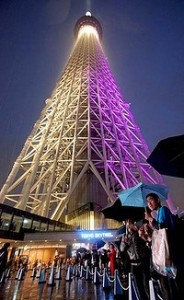Source: www.theage.com.au
Danielle Demetriou climbs Tokyo’s towering Skytree for an unsurpassed view of the capital.

At first I am too close to see it properly. Emerging from a shiny new train station, I am politely ushered by raincoat-clad staff into the stream of umbrellas moving along the street. Finally, I stop, crane my neck sharply upwards and, despite the rain, see it in all its glory – Tokyo Skytree.
I am among tens of thousands of visitors who have travelled to the Sumida River area of eastern Tokyo to witness the opening of Japan’s most eagerly awaited new attraction.
Tokyo is awash with skyscrapers offering bird’s-eye views across the city. All are eclipsed by the Skytree, which not only dominates the city’s skyline but is also the world’s tallest free-standing tower (at 634 metres, it is almost double the height of the Eiffel Tower, but falls short of the 828 metres recorded by the world’s tallest building, the Burj Khalifa in Dubai).
The Skytree is now the city’s broadcasting tower, a function undertaken since 1958 by the Tokyo Tower, a red-and-white structure inspired by the Eiffel Tower that symbolised the country’s postwar development but now looks decidedly toylike.
The new tower has two public observatories offering 360-degree views and is open to 10pm. The 200,000 visitors who turn up on opening day testify to the fact that it is being taken to the nation’s heart – the tower already has its own brand of perfume and an anime-style (cartoon) mascot, Sorakara-chan, a little girl with a star head.
As my queue slowly snakes towards the building, the intricate latticework of the ice-blue-tinged white structure, inspired by Japanese pagoda architecture, comes into view. Not visible, but reassuring, is its sophisticated anti-disaster technology, including lifts encased in hollow concrete tubing to halve the impact of earthquake vibrations.
Among those there on opening day is Anai Mitsuko, a sprightly 64-year-old clutching a wide-eyed grandson by the hand.
“I live nearby and have watched it growing taller every day for years,” Mitsuko says. “Now it’s finished, it’s a relief. It marks a big change for Tokyo.”
Then it is time to see the top: staff in cartoon-chic uniforms of yellow and blue usher visitors into one of four lifts that speed to the two observatories, at 350 metres and 450 metres.
Views of dense, white clouds fail to diminish the enthusiasm of camera-snapping visitors gazing through curved walls of glass. “The weather is not ideal,” a PR manager for the tower, Hirotake Takanashi, says. “But on a clear day, you can see everything: Mount Fuji, entire neighbourhoods, even a stretch of coastline in the distance.”
The timing of the Skytree’s opening is fortunate. As well as revitalising the Asakusa area (containing, among other attractions, the Sensoji temple), the tower’s completion a year after the earthquake and tsunami disaster is seen as a sign of the nation’s recovery.
Mitsuko certainly sees it as a much-needed morale booster. “This area is going to change,” she says, “and it will be good to see lots of young people visiting.” More info
The Tokyo Skytree is open daily, 8am-10pm. Tickets until July 10 have already been allocated via an online lottery system. From July 11, tickets can be bought on the day. It costs from ¥2000 ($26) to visit the first deck and an additional ¥1000 to go to the second. The Skytree is on the Tobu train line and can also be accessed via Oshiage Station (Hanzomon, Asakusa lines). See tokyo-skytree.jp/en.














